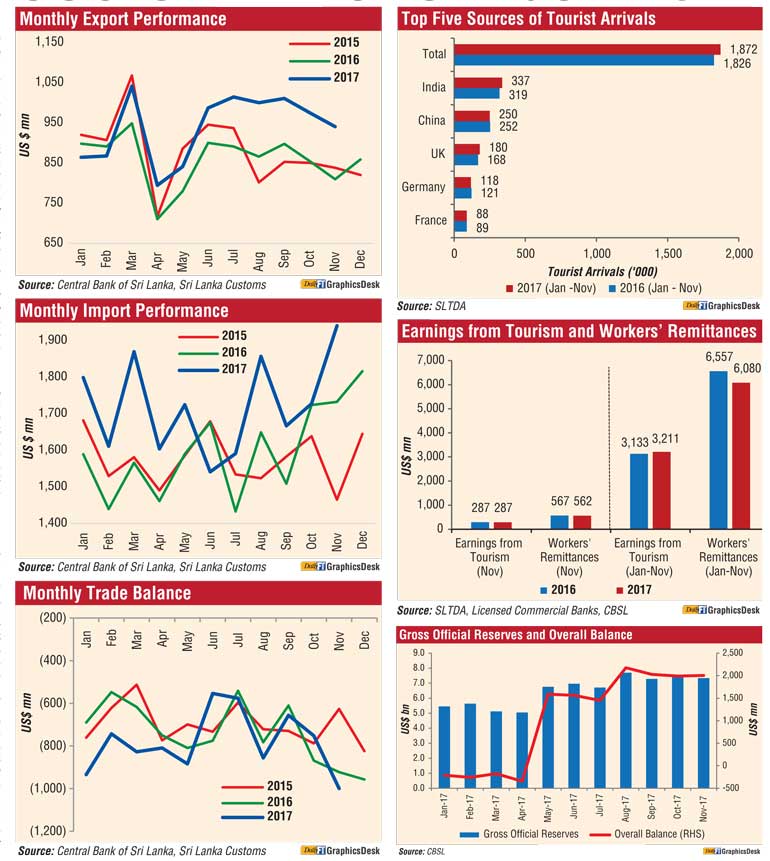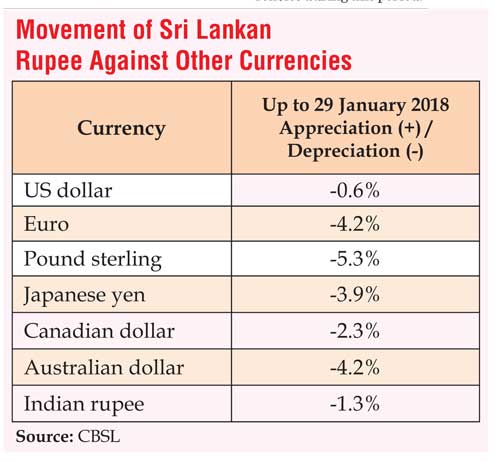Sunday Dec 07, 2025
Sunday Dec 07, 2025
Thursday, 1 February 2018 00:00 - - {{hitsCtrl.values.hits}}

The Central Bank on 30 January said the external sector performance in November 2017 was supported by continued inflows to the financial account of the Balance of Payments (BOP), mainly with higher foreign inflows to the government securities market, and marginally improved earnings from tourism.
It said although a double-digit growth in exports has been recorded, partly driven by the low base recorded in November 2016, the trade deficit expanded considerably during the month with higher imports. Meanwhile, workers’ remittances continued to decline, owing to adverse economic and geopolitical conditions prevailing in the Middle-Eastern region. Accordingly, the BOP recorded an overall surplus of around $ 2.0 billion by end November 2017. Gross official reserves also increased to $ 7.3 billion (equivalent to 4.2 months of imports) by end November 2017 from $ 6.0 billion recorded at end 2016.
Trade Balance
The deficit in the trade balance expanded in November 2017, while the trade deficit on a cumulative basis also widened during the first eleven months of 2017 in comparison to the value recorded during the corresponding period of the previous year. This was due to higher import expenditure on account of increased expenses on fuel imports.
Performance of Merchandise Exports
Exports continued to record a double-digit growth for the fifth consecutive month in November 2017. However, this growth was partly driven by the low base recorded in November 2016. Earnings from textiles and garments exports contributed largely for this growth. Export earnings from garments increased for the fifth consecutive month in November 2017 with increased demand from the EU and the US and non-traditional markets such as Australia, Hong Kong and UAE. 
Following the restoration of the GSP+ facility, earnings from garment exports to the EU continued to expand, and in November 2017, it grew by 13.8% (year-on-year), while garment exports to the US increased by 11.9%.
Further, earnings from the exports of petroleum products increased notably owing to higher export volumes and export prices of bunker and aviation fuel.
Also, reflecting higher earnings from rubber tyres and surgical and other gloves, earnings from rubber products increased during the month.
Meanwhile, earnings from agricultural exports increased further in November 2017, mainly due to the notable growth recorded in tea exports in view of increase in the average tea export prices and volumes. Earnings from spices increased with higher volumes of cinnamon, pepper and cloves, despite the decline in average export prices.
In addition, earnings from seafood exports increased significantly during the month, mainly due to increased exports to the EU market, reflecting the positive impact of the removal of the ban on exports of fisheries products to the EU market and the restoration of the GSP+ facility.
In November 2017, the US, the UK, India, Germany and Italy were the leading markets for merchandise exports of Sri Lanka accounting for about 50% of total exports.
Performance of Merchandise Imports
Reporting the highest monthly value since November 2011, expenditure on imports increased significantly in November 2017. This was due to high expenditure incurred for fuel imports as a result of significant increase in crude oil and refined petroleum products, on account of the combined effect of higher prices in the international market and increased import volumes.
Import expenditure on wheat and maize increased significantly due to the base effect. Further, expenditure on gold imports increased considerably during the month, owing to higher volumes of gold imports. In view of the measures taken to fulfil the shortage of rice in the domestic market, volume of rice imports further increased in November 2017. Imports expenditure on dairy products also increased significantly with the increased volumes and average prices of milk powder.
Cement clinkers, categorised under mineral products, and cement, categorised under building materials, led to increase in construction industry related import expenditure. However reflecting lower imports of iron and steel, import expenditure on base metals related to the construction industry declined in November 2017.
Expenditure on fertiliser imports declined in November 2017 mainly due to the lower imports of urea. Sugar imports also declined for the fifth consecutive month in November 2017 owing to the decline registered in average import prices and volumes.
Import expenditure on investment goods declined, mainly due to the decline in transport equipment imports reflecting lower imports of lorries, auto trishaws, commercial cabs and agricultural tractors together with the base effect of other transport equipment such as chassis and railway track construction materials as higher imports recorded under those items in November 2016.
India, China, UAE, Singapore and Japan were the main import origins accounting for 58% of total imports in November 2017.
Other Major Inflows to the Current Account
In November 2017, tourist arrivals increased marginally in comparison to November 2016, while earnings from tourism also recorded a marginal increase during the month. The top five sources of tourist arrivals, namely, India, China, the UK, Germany and France accounted for 52.0% of total tourist arrivals up to end November 2017. On a cumulative basis, tourist arrivals and earnings from tourism increased during the first eleven months of 2017 compared to the corresponding period of 2016. Meanwhile, workers’ remittances declined by 0.9% during November 2017. Overall, workers’ remittances recorded a year-on-year decline of 7.3% during the year up to end November 2017.

Financial Flows
Despite the slower than expected improvement in the current account, the financial account of the BOP continued to strengthen during the month of November 2017. Continuing the positive trend recorded since March 2017, foreign investments to the government securities market witnessed net inflows for the ninth consecutive month. In addition, long term loans to the government increased on a net basis during the first eleven months of the year.
Meanwhile, foreign investments in the Colombo Stock Exchange (CSE) recorded a net outflow during the month of November 2017 mainly due to a one-off transaction of a local company acquiring the foreign stake of a company operating in Sri Lanka. However, on a cumulative basis, foreign investments in the CSE recorded a significant net inflow during the first eleven months of 2017, in comparison to the net outflow recorded during the corresponding period of 2016.
International Reserves
Sri Lanka’s gross official reserves increased from $ 6.0 billion recorded as at end 2016 to $ 7.3 billion by end November 2017, which are sufficient to finance 4.2 months of imports. Total foreign assets, which include foreign assets of the banking sector, also increased to $ 9.7 billion (equivalent to 5.6 months of imports) from $ 8.4 billion recorded as at end 2016.
Exchange Rate Movements
The Sri Lankan rupee recorded a depreciation of 0.6% against the US dollar in 2018, up to 29 January, in comparison to the depreciation of 2.0% recorded during 2017. Furthermore, reflecting cross currency movements, the rupee also depreciated against other major currencies during this period.